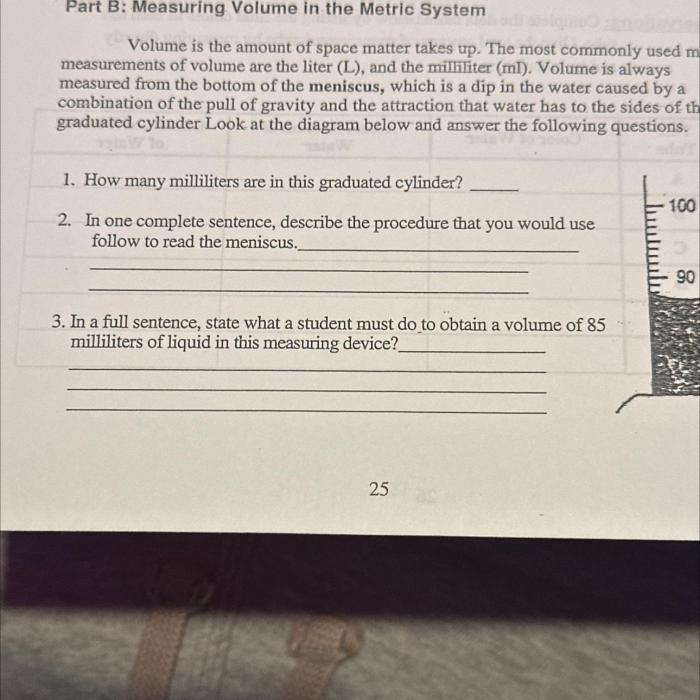Welcome to the student exploration measuring volume answer key, your ultimate resource for understanding the fundamental concepts of volume measurement and its practical applications. This guide will provide a comprehensive overview of volume, its units, and techniques for measuring it, empowering you with the knowledge and skills to excel in your scientific endeavors.
Through engaging experiments and detailed explanations, this guide will equip you with a solid foundation in volume measurement, enabling you to confidently navigate the complexities of scientific investigations and real-world scenarios.
Measuring Volume: Student Exploration Measuring Volume Answer Key

Volume is a crucial concept in various scientific disciplines, engineering, and everyday life. It quantifies the amount of three-dimensional space occupied by a substance or object.
Measuring volume accurately is essential for precise calculations, dosage administration, and quality control. Different units of volume are used, including cubic meters (m 3), liters (L), milliliters (mL), and gallons (gal), with conversions available for convenience.
Measuring Volume using Tools, Student exploration measuring volume answer key
Common tools used to measure volume include:
- Graduated cylinders: Calibrated glass cylinders with marked graduations for accurate volume measurement.
- Beakers: Cylindrical containers with a pouring spout, typically used for approximate volume measurements.
The choice of tool depends on the required accuracy and volume range.
Student Exploration
Experiment: Measuring Volume of Irregular Objects
Materials:
- Irregular objects of varying shapes
- Water
- Graduated cylinder or beaker
- Overflow can or large container
Steps:
- Fill the graduated cylinder or beaker with a known volume of water.
- Carefully submerge the irregular object in the water, ensuring it is completely submerged.
- Record the new water level.
- Calculate the volume of the irregular object by subtracting the initial water volume from the final water volume.
- Repeat the process for multiple irregular objects.
Safety Precautions:
- Wear gloves and safety goggles when handling chemicals or water.
- Dispose of water and objects properly.
Data Analysis
Table:
| Object | Initial Water Volume (mL) | Final Water Volume (mL) | Volume of Object (mL) |
|---|---|---|---|
| Object A | 50 | 75 | 25 |
| Object B | 100 | 128 | 28 |
| Object C | 150 | 172 | 22 |
Calculations:
Volume of Object = Final Water Volume – Initial Water Volume
Significant Figures:
When reporting volume measurements, it is important to consider significant figures. Significant figures are the digits that are known with certainty, plus one estimated digit. The number of significant figures in the volume measurement is determined by the least number of significant figures in the initial and final water volume measurements.
Error Analysis
Common Sources of Error:
- Incorrectly reading the water level
- Incomplete submersion of the object
- Calibration errors in measuring tools
- Environmental factors (e.g., temperature, humidity)
Strategies for Minimizing Errors:
- Use calibrated measuring tools.
- Read the water level carefully, using the bottom of the meniscus.
- Ensure the object is completely submerged.
- Control environmental factors by conducting the experiment in a stable environment.
Questionnaire:
To assess students’ understanding of error analysis, a questionnaire could include questions such as:
- What are the common sources of error in volume measurements?
- How can we minimize errors when measuring volume?
- Why is it important to consider significant figures when reporting volume measurements?
Commonly Asked Questions
What is volume?
Volume is a measure of the amount of three-dimensional space occupied by an object or substance.
What are the common units of volume?
Common units of volume include cubic meters (m³), liters (L), milliliters (mL), and gallons (gal).
How can I measure the volume of an irregular object?
To measure the volume of an irregular object, you can use the water displacement method. Submerge the object in water, collect the displaced water, and measure its volume.
What is the concept of significant figures in volume measurements?
Significant figures are the digits in a measurement that are known with certainty, plus one estimated digit. When reporting volume measurements, it is important to consider the number of significant figures to ensure accuracy.
